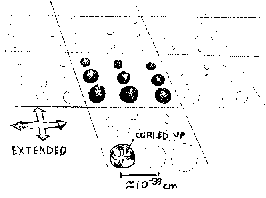
Hyperspace theory (also called Superstring or Supergravity theory) begins
with Einstein's General Relativity. In 1919, Theodr Kaluza, building upon
relativity, made an astounding discovery: light and gravity can be unified
and expressed with identical mathematics. This was the beginning of the
unification of all physical laws, which is the ultimate goal of physics.
There was only one catch. He needed an extra dimension. This fifth dimension,
long recognized as mathematically plausible, had never before been seriously
proposed as an actual component of reality. The usefulness of his theory
was hard to deny; in five dimensions, there is "enough room"
to accomplish the unification of gravity and light, which simply cannot
be accomplished when trapped in four dimensional spacetime.
There is an obvious question to be asked at this point. "Where
is the fifth dimension?" Kaluza's answer is clever, though suspiciously
hard to test. He said that the fifth dimension is too small to see.
The fifth dimension is contiguous with our four, but it is curled up, while
the others are extended. To understand curled-up dimensions, imagine an
ant living on a string (or a Linelander).  For
all its life, it is only aware of two directions: forward and backward.
It lives in a one-dimensional universe. However, if you examine the string
very closely, you find that it has a circumference; an extra dimension,
curled up and wrapped back onto itself into a circle. If you could stretch
this dimension, that is, make the circumference very large, the ant would
be living on the two-dimensional surface of a cylinder. But when it's curled
up, it effectively is undetectable by the ant, though it may serve as a
medium for vibrations or other physical effects.
For
all its life, it is only aware of two directions: forward and backward.
It lives in a one-dimensional universe. However, if you examine the string
very closely, you find that it has a circumference; an extra dimension,
curled up and wrapped back onto itself into a circle. If you could stretch
this dimension, that is, make the circumference very large, the ant would
be living on the two-dimensional surface of a cylinder. But when it's curled
up, it effectively is undetectable by the ant, though it may serve as a
medium for vibrations or other physical effects.
This Kaluza-Klein Theory (named after Kaluza and one of his students)
was a curiosity for a while until people became disenchanted with its bizarre
hypotheses and lack of concrete predictions. A common criticism was to ask why, if there could be one extra dimension, why not many? Just how many dimensions did this wacky theory have? For many years, people were content to leave gravity
behind and work on examining the nature of subatomic matter via
Quantum Mechanics.
Fortunately, in the 1980's, Kaluza-Klein came back with a vengence.
The new wave of physicists supporting Hyperspace ("higher"-space)
theories had an important element which was missing in the thirties: an
exact prediction of the number of dimensions in our universe. By manipulating
the formulae of Einstein, Riemann, and the like, they managed to unify
all the forces of nature (gravity, the strong and weak nuclear forces,
and the electromagnetic force, which includes light) in a single theory.
How many dimensions did they need? Ten.

According to Hyperspace theory, each point in our four-dimensional universe
conceals an additional six curled-up dimensions. The image at left provides
insight on how this might be possible. Here we have a two-dimensional plane
viewed at great magnification. At each point in the plane, there are the
two curled-up dimensions of a sphere. In our universe, each point contains
not a sphere, but a higher-dimensional object: a six-dimensional "Calabi-Yau
Manifold." There is a very simple reason why we can't see these
manifolds: they are less than 10^-33 centimeters across, much smaller than
our most powerful microscopes can detect. Nonetheless, the movement of
vibrating "strings" through these manifolds
may be the source of all of physics.
 For
all its life, it is only aware of two directions: forward and backward.
It lives in a one-dimensional universe. However, if you examine the string
very closely, you find that it has a circumference; an extra dimension,
curled up and wrapped back onto itself into a circle. If you could stretch
this dimension, that is, make the circumference very large, the ant would
be living on the two-dimensional surface of a cylinder. But when it's curled
up, it effectively is undetectable by the ant, though it may serve as a
medium for vibrations or other physical effects.
For
all its life, it is only aware of two directions: forward and backward.
It lives in a one-dimensional universe. However, if you examine the string
very closely, you find that it has a circumference; an extra dimension,
curled up and wrapped back onto itself into a circle. If you could stretch
this dimension, that is, make the circumference very large, the ant would
be living on the two-dimensional surface of a cylinder. But when it's curled
up, it effectively is undetectable by the ant, though it may serve as a
medium for vibrations or other physical effects.
